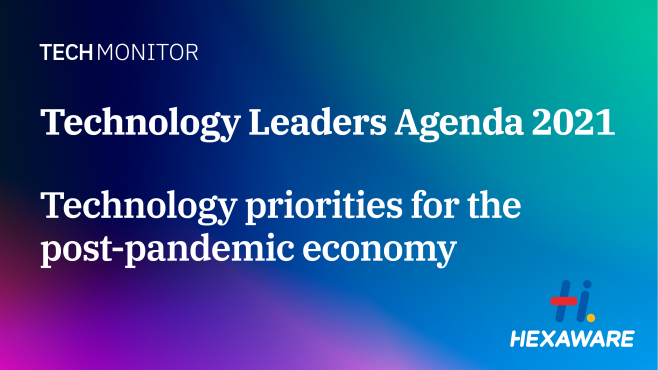
Technology and business leaders are putting data integration and data architecture initiatives at the heart of their transformation strategies, and are implementing AI now that those innovations are reaching enterprise maturity.
In the Technology Leaders Agenda 2021, an independent editorial research report supported by partners Hexaware, data infrastructure and data integration were cited as the main focus of technology programmes for 2021 by 68% of respondents, ahead of implementing AI and automation initiatives (61%).
Download the Technology Leaders Agenda 2021 survey
With the research showing growth and transformation are the top priorities for their organisations, this puts technology leaders and the exploitation of data capabilities at the heart of digital business agendas.
The research also found that data analytics was the area where technology leaders expected their investments to grow the fastest, and is only behind cybersecurity for where the most technology investment is going in the coming year.
Members of the Technology Leaders Agenda 2021 advisory panel of CIOs and CTOs said that after years of hype around AI, innovations in the data ecosystem had finally reached enterprise maturity. As such, it was no surprise that AI and automation initiatives are increasingly being implemented. “AI and automation are now solidly delivering the use cases and value promised three years ago,” says Nadine Thomson, global CTO at MediaCom.
But enterprise AI and automation projects can only provide business value if the organisation has robust data management and architecture, Thomson added. “Success is dependent on establishing solid foundations that are clean data sets and consistent processes. Don’t underestimate the time and effort required to set good foundations. Some 80% of the time delivering an AI initiative is spent on crafting, connecting and cleaning data.”
Indeed, Thomson previously spoke to Tech Monitor at the end of 2020 about how it had taken years of accumulating ad performance data for her team at MediaCom to scale an AI pilot that helped optimise certain elements of particular adverts.
Dominic Howson was IS and supply chain director at bread maker Hovis before he joined waste management and recycling company Viridor in January 2020. Also part of the steering panel, Howson said that AI and automation technologies had definitely reached enterprise maturity.
“In the last 12 months, in my previous business we had delivered our AI-driven demand forecasting toolset, we had launched a trial of a complaint prediction toolset, and had various other solutions in development,” Howson says.
“In the new business, we aren’t ready with the underpinning data structure, but we will be there shortly. The tools are there, and it’s just a case of whether it can be delivered internally with capability or with a partner.”
Technology Leaders Agenda 2021: Data skills
The Technology Leaders Agenda 2021 showed that CIOs, CTOs and their peers were primarily focused on people and culture ahead of IT project delivery – in particular, keeping staff motivated and engaged, and attracting and retaining the best tech talent to drive transformation for their organisations.
While investing significantly in data analytics toolsets and implementing data and AI initiatives, tech leaders also responded that business analysts and data scientists were two of the most in-demand roles at their companies, behind only cybersecurity and cloud specialists.
Furthermore, more than half of respondents described business analysts as difficult to hire, and an overwhelming 77% said data scientists were difficult to recruit – behind only enterprise architects and cloud specialists as the hardest to appoint.
The report suggests, therefore, that data investments, initiatives and skills could be set to shape technology functions for years to come, a view supported by Thomson, who added that developing some data capabilities was something all employees should aspire to, rather than confining data expertise to a specialist silo.
“Data skills have become more important as it is the foundation for our business and all of our technology products,” she says. “Understanding the core principles of data architecture, data organisation and data management is a core skill for everyone in our technology function.”
What next for the chief data officer?
While technology leaders are focusing heavily on data initiatives, the Technology Leaders Agenda 2021 showed that despite the emergence of the chief data officer role in the last decade, the CIO and CTO is still overwhelmingly likely to be the most senior technology role at a given organisation.
The chief data officer was cited as the most senior technology role by just 1% of respondents. Clearly not a reflection of the significance of data implementation and exploitation at an organisation, the research steering board suggested that even though specific chief data officer roles might not be necessary, responsibility for data should be shared between the technology function and other business units.
“There are two sides to ‘data ownership’,” says Howson. “Tech leaders are responsible for making data accessible, for its availability, its transformation and the capability to compare, contrast and layer different data sets. We cannot forget that the business should hold responsibility for its data quality and the inputs – it’s a key discussion between IT and the business to understand the rulebook of data.”
Download the Technology Leaders Agenda 2021 survey here.






